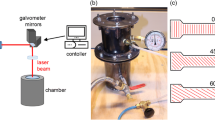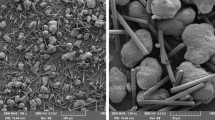Abstract
During the selective laser sintering layer-by-layer manufacturing process, many factors such as the ambient temperature and the densification effect will influence the mechanical properties of sintered specimens. In the experimental study, the porosity ratio, crystallinity, and tensile strength of sintered specimens with different ambient temperatures and layers were analyzed. The results indicated that when the ambient temperature rose from 25 to 180 °C, the average porosity ratio decreased from 60% at 25 °C to 39.7–38.7% at 140–180 °C; the relative crystallinity and tensile strength reached a maximum value of 34% and 10 MPa at 140 °C with the same number of sintered layers. According to the measurement of sintered specimens with different layers, the porosity ratio rapidly reduced by 21% from 3 to 10 layers, and the tensile strength improved by 22.5 MPa. When the number of sintered layers reached 10, the change of the porosity ratio and tensile strength were relatively slow, and it would almost disappear as the number of layers exceeded 14. The results showed that the densification process and energy accumulation effect were beneficial to reduce the porosity ratio of specimens, thereby improving its tensile strength in the early period of laser sintering.
Similar content being viewed by others
References
Jacobs PF (1992) Rapid prototyping & manufacturing: fundamentals of stereolithography. Society of Manufacturing Engineers
Bourell DL, Marcus HL, Barlow JW, Beaman JJ (1992) Selective laser sintering of metals and ceramics. Int J Powder Metall 28(4):369–381
Eshraghi S, Das S (2010) Mechanical and microstructural properties of polycaprolactone scaffolds with one-dimensional, two-dimensional, and three-dimensional orthogonally oriented porous architectures produced by selective laser sintering. Acta Biomater 6(7):2467–2476. https://doi.org/10.1016/j.actbio.2010.02.002
Chacón JM, Caminero MA, García-Plaza E, Núñez PJ (2017) Additive manufacturing of PLA structures using fused deposition modelling: effect of process parameters on mechanical properties and their optimal selection. Mater Des 124:143–157. https://doi.org/10.1016/j.matdes.2017.03.065
Mägi P, Krumme A, Pohlak M (2016) Recycling of PA-12 in additive manufacturing and the improvement of its mechanical properties. Key Eng Mater 674:9–14. https://doi.org/10.4028/www.scientific.net/KEM.674.9
Karimi P, Raza T, Andersson J, Svensson LE (2017) Influence of laser exposure time and point distance on 75-μm-thick layer of selective laser melted alloy 718. Int J Adv Manuf Technol 94(5–8):2199–2207. https://doi.org/10.1007/s00170-017-1019-1
Feng Q, Tang Q, Liu Y, Setchi R, Soe S, Ma S, Bai L (2017) Quasi-static analysis of mechanical properties of Ti6Al4V lattice structures manufactured using selective laser melting. Int J Adv Manuf Technol 94(5–8):2301–2313. https://doi.org/10.1007/s00170-017-0932-7
Fayed EM, Elmesalamy AS, Sobih M, Elshaer Y (2017) Characterization of direct selective laser sintering of alumina. Int J Adv Manuf Technol 94(5–8):2333–2341. https://doi.org/10.1007/s00170-017-0981-y
Zhu W, Yan C, Shi Y, Wen S, Liu J, Shi Y (2015) Investigation into mechanical and microstructural properties of polypropylene manufactured by selective laser sintering in comparison with injection molding counterparts. Mater Des 82:37–45. https://doi.org/10.1016/j.matdes.2015.05.043
Lisi Leite J, Salmoria GV, Paggi RA, Ahrens CH, Pouzada AS (2011) Microstructural characterization and mechanical properties of functionally graded PA12/HDPE parts by selective laser sintering. Int J Adv Manuf Technol 59(5–8):583–591. https://doi.org/10.1007/s00170-011-3538-5
Salmoria GV, Ahrens CH, Klauss P, Paggi RA, Oliveira RG, Lago A (2007) Rapid manufacturing of polyethylene parts with controlled pore size gradients using selective laser sintering. Mater Res 10(2):211–214
Kim J, Creasy TS (2004) Selective laser sintering characteristics of nylon 6/clay-reinforced nanocomposite. Polym Test 23(6):629–636. https://doi.org/10.1016/j.polymertesting.2004.01.014
Salmoria GV, Leite JL, Vieira LF, Pires ATN, Roesler CRM (2012) Mechanical properties of PA6/PA12 blend specimens prepared by selective laser sintering. Polym Test 31(3):411–416. https://doi.org/10.1016/j.polymertesting.2011.12.006
Zarringhalam H, Majewski C, Hopkinson N (2009) Degree of particle melt in nylon-12 selective laser-sintered parts. Rapid Prototyp J 15(2):126–132. https://doi.org/10.1108/13552540910943423
Zarringhalam H, Hopkinson N, Kamperman NF, de Vlieger JJ (2006) Effects of processing on microstructure and properties of SLS nylon 12. Mater Sci Eng A 435-436:172–180. https://doi.org/10.1016/j.msea.2006.07.084
Zhou W, Wang X, Hu J, Zhu X (2013) Melting process and mechanics on laser sintering of single layer polyamide 6 powder. Int J Adv Manuf Technol 69(1–4):901–908. https://doi.org/10.1007/s00170-013-5113-8
Cavazzuti M (2013) Design of experiments. In: Optimization methods. Springer, pp 13–42
Wu H (2013) Application of orthogonal experimental design for the automatic software testing. In: Appl Mech Mater. Trans Tech Publ, pp 812–818
Ren JW, Dong LJ (2012) Effect of process parameters on residual thermal stress in laser sintering process. Innovation and Sustainability of Modern Railway 551–556
Mercelis P, Kruth JP (2006) Residual stresses in selective laser sintering and selective laser melting. Rapid Prototyp J 12(5):254–265. https://doi.org/10.1108/13552540610707013
Fischer C, Seefried A, Drummer D (2017) Crystallization and component properties of polyamide 12 at processing-relevant cooling conditions. Polym Eng Sci 57(4):450–457. https://doi.org/10.1002/pen.24441
Zhang X, Yang G, Lin J (2006) Crystallization behavior of nylon 11/montmorillonite nanocomposites under annealing. J Appl Polym Sci 102(6):5483–5489. https://doi.org/10.1002/app.23900
Dadbakhsh S, Verbelen L, Verkinderen O, Strobbe D, Van Puyvelde P, Kruth J-P (2017) Effect of PA12 powder reuse on coalescence behaviour and microstructure of SLS parts. Eur Polym J 92:250–262. https://doi.org/10.1016/j.eurpolymj.2017.05.014
Zhang X, Li YB, Zuo Y, Lv GY, Mu YH (2006) Influences of the crystallization behavior of n-HA reinforced PA66 biocomposite on its mechanical properties. Mater Sci Forum 510-511:898–901. https://doi.org/10.4028/www.scientific.net/MSF.510-511.898
Coniglio N, Sivarupan T, El Mansori M (2017) Investigation of process parameter effect on anisotropic properties of 3D printed sand molds. Int J Adv Manuf Technol 94(5–8):2175–2185. https://doi.org/10.1007/s00170-017-0861-5
Zhang Y, Zhang Y, Liu S, Huang A, Chi Z, Xu J, Economy J (2011) Phase stability and melting behavior of the α and γ phases of nylon 6. J Appl Polym Sci 120(4):1885–1891. https://doi.org/10.1002/app.33047
Acknowledgements
The technical assistance from State Key Laboratory (USTC) is gratefully acknowledged.
Funding
This study received financial support from the Key Research and Development Program of Anhui (grant number 1704a0902051).
Author information
Authors and Affiliations
Corresponding author
Rights and permissions
About this article
Cite this article
Ling, Z., Wu, J., Wang, X. et al. Experimental study on the variance of mechanical properties of polyamide 6 during multi-layer sintering process in selective laser sintering. Int J Adv Manuf Technol 101, 1227–1234 (2019). https://doi.org/10.1007/s00170-018-3004-8
Received:
Accepted:
Published:
Issue Date:
DOI: https://doi.org/10.1007/s00170-018-3004-8




